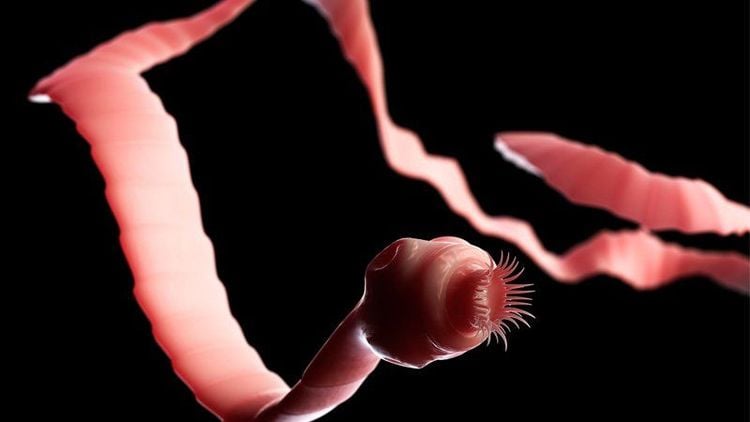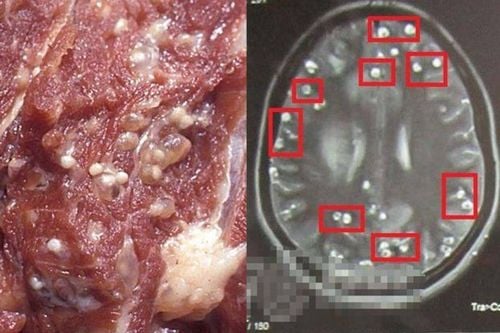This is an automatically translated article.
Swine flu is a human parasite that is relatively common in Asian countries and areas with poor sanitation. People get tapeworms by eating undercooked meat with cysts.1. Pork fluke
After cysts enter the body, they will mature into adult flukes, laying eggs. Ingesting food containing flukes (fluids in soil, in vegetables...) will hatch into larvae and become flukes in the pig's body. The life cycle of tapeworm eggs can be up to 30 years in the host.
When infected with adult flukes in the small intestine, some patients may develop disorders of intestinal motility. This can cause the tapeworms to be pushed back into the stomach, leading to a large number of eggs being released and causing severe larval disease in the patient.
2. How does swine flu spread to humans?
Through eating, the patient is infected with tapeworms through the following 3 ways:
First: The patient eats undercooked food, pork containing cysts. Second: in food, raw vegetables, in water, there are eggs of fluke, the patient accidentally swallows it or puts it in his mouth with infected hands. Third: People infected with adult flukes swallow old tapeworms into the stomach when vomiting. If you suspect that you have eaten undercooked pork contaminated with tapeworms, your risk of developing adult tapeworm disease is very high. In this case, the adult hydatid cyst will develop in the patient's intestine in 8-10 weeks. If the above time has passed, it is possible to look with a microscope to look for eggs or to find tapeworms in the stool. If this is not enough time, use ELISA to detect antigens in the stool.

Nhiễm sán lợn có nguy hiểm không?
3. Manifestations of swine flu infection
3.1. Clinical Manifestations
Cases of adult fluke infection: Adult tapeworm infection often has no obvious symptoms, some patients may have abdominal pain, digestive system disorders, symptoms of body weakness, ....Yes In many cases, the patient can see the tapeworm burning in the stool. Eggs were detected during a stool examination. Infection with tapeworms (swine tapeworm): Larvae are formed anywhere in the patient's body. Patients have different severe clinical manifestations depending on the number of larval cysts and the location of the cysts. If only a few cysts are present, patients are usually asymptomatic or, if present, have only mild myalgia. When the larvae move into the eye, it will cause symptoms such as decreased vision, eye pain, lacrimation, pain, glaucoma, double vision, blindness...depending on the location of the cyst. When the larval cyst resides in the brain, it will cause symptoms such as confusion, seizures, slurred speech...
3.2. Subclinical Manifestations
With adult flukes: By ELISA technique, antigens are detected in feces. A segment of 4-6 segments detected in feces Adult tapeworm segments or eggs are found by fecal examination With tapeworm larvae : Biopsy of fluke cysts to find eggs Using ELISA technique, to detection of antibodies and larval antigens Ophthalmoscopy to determine if cysts are suspected in the eye Brain scan to look for specific cystic images.

Sử dụng kỹ thuật ELISA, để phát hiện kháng thể và kháng nguyên ấu trùng
4. Is swine flu infection dangerous?
Due to eating habits, pork containing cysts (rice pork flukes) has not been cooked, patients are at high risk of contracting pork tapeworms and larvae of pork tapeworms. These larvae turn into cysts after traveling through the bloodstream into the human body, to the muscles, eyes, and brain.
Depending on the location of the cyst, the patient will have different symptoms. If the cyst is located in the body, there will be small tumors, about 1-2 cm in size, or the size of a pea or peanut, without itching, no pain. In cases where the cyst is located in the brain, it can cause symptoms such as seizures, convulsions, headaches, paralysis of the limbs or hemiplegia. In cases where the cyst is located in the eye, it can cause symptoms such as glaucoma, decreased vision, double vision, blindness...
In the case of adult tapeworm infection in the intestines, when entering the stomach thick, tapeworm larvae will escape from the cyst and adhere to the small intestine, developing into an adult tapeworm. Adult tapeworms develop gradually by budding, producing new nodes from the neck, creating thousands of new tapeworms. There are about 50,000 eggs in each tapeworm. Adult flukes can be up to 2-12cm in length, they will live for many years in the small intestine.
Because patients infected with adult tapeworms have no typical signs and symptoms, the patient does not have a fever, etc., so they often do not seek medical attention and treatment. Long-term fluke infection causes physical impairment, digestive disorders, if the disease lasts for many years, it will make the patient emaciated.
Whether the infection is dangerous or not depends on the location of the tapeworm, the parasitic cyst. Severe cases can cause seizures, hemiplegia or blindness,... Therefore, this disease should not be subjective. If you suspect that you have a fluke infection, you should go to medical facilities for examination to detect and treat promptly.
Please dial HOTLINE for more information or register for an appointment HERE. Download MyVinmec app to make appointments faster and to manage your bookings easily.













